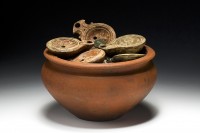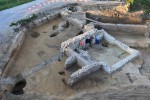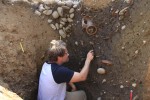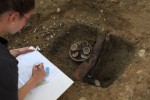 Archaeologists excavating the site of a Roman fort and civilian settlement in the northern Swiss city of Windisch have unearthed an unusual hoard: a cooking pot filled with lamps, each containing a single bronze coin. What is now the Zürcherstrasse, one of Windisch’s busiest streets, in the first century A.D. was the defensive wall of the Roman legionary camp of Vindonissa. It was established in the province of Germania Superior around 15 A.D. and was occupied by various legions until 101 A.D., after which it was integrated into the civilian settlement. The ancient town was inhabited through the 5th century.
Archaeologists excavating the site of a Roman fort and civilian settlement in the northern Swiss city of Windisch have unearthed an unusual hoard: a cooking pot filled with lamps, each containing a single bronze coin. What is now the Zürcherstrasse, one of Windisch’s busiest streets, in the first century A.D. was the defensive wall of the Roman legionary camp of Vindonissa. It was established in the province of Germania Superior around 15 A.D. and was occupied by various legions until 101 A.D., after which it was integrated into the civilian settlement. The ancient town was inhabited through the 5th century.
 The Aargau Canton archaeology department has been excavating the site south of Zürcherstrasse where a multi-use development with underground garage will be constructed, since 2013. They’ve discovered the remains of defensive earthworks, well-preserved stone buildings, fireplaces, a latrine pit and a deep brick shaft.
The Aargau Canton archaeology department has been excavating the site south of Zürcherstrasse where a multi-use development with underground garage will be constructed, since 2013. They’ve discovered the remains of defensive earthworks, well-preserved stone buildings, fireplaces, a latrine pit and a deep brick shaft.
 It was in the brick shaft that archaeologists found the pot, the kind of quotidian vessel the legionaries at Vindonissa would have used to cook their food, entirely intact and in exceptionally good condition. Inside were 22 oil lamps. They too were implements used by regular people in their daily life. They were filled with oil and lit at the spout end. Produced in enormous quantities and sold all over the empire, the lamps were often decorated on the top side with designs which would glow in the light. The lamps collected inside the pot are decorated with a variety of motifs: a flower, the moon goddess Luna, a winged Cupid, a defeated gladiator, a lion, a peacock, even an erotic scene.
It was in the brick shaft that archaeologists found the pot, the kind of quotidian vessel the legionaries at Vindonissa would have used to cook their food, entirely intact and in exceptionally good condition. Inside were 22 oil lamps. They too were implements used by regular people in their daily life. They were filled with oil and lit at the spout end. Produced in enormous quantities and sold all over the empire, the lamps were often decorated on the top side with designs which would glow in the light. The lamps collected inside the pot are decorated with a variety of motifs: a flower, the moon goddess Luna, a winged Cupid, a defeated gladiator, a lion, a peacock, even an erotic scene.
 An as, a bronze coin that was lowest value currency in the early Roman Empire, was placed inside each lamp. Almost all of the coins date to 66 and 67 A.D., a range that fits the style of the cooking pot and lamps. Because asses were of such low value, their inclusion in this odd assemblage is likely symbolic.
An as, a bronze coin that was lowest value currency in the early Roman Empire, was placed inside each lamp. Almost all of the coins date to 66 and 67 A.D., a range that fits the style of the cooking pot and lamps. Because asses were of such low value, their inclusion in this odd assemblage is likely symbolic.
“What astonished us was the quantity and the combination of coins and lamps,” said Aargau cantonal archaeologist Georg Matter.
“We suspect this is a ritual burial,” he said, but stressed that was only speculation since there haven’t been any other comparable discoveries.
The pot also contained charred fragments of animal bones, ruling it out as a urn for human remains.
“The intentions behind this burial are puzzling at the moment,” added Matter.
The pot has been fully excavated in the laboratory, the lamps catalogued and photographed. Next on the schedule is examination of the coins by numismatic experts and the analysis of the bone fragments.
Thank You! Your posts are always the best.
Thank you for the kind words. :thanks:
Could the coin have been put there simply for the oil to be used?
You mean to raise the oil level to preserve fuel? I could see that being done if the lamps were found in their natural habitat (in a room in a building, say), but it doesn’t seem likely when they were empty and all packed together in a pot.
“one of Windisch’s busiest streets”: hm. Windisch has a population of 7,361.
Hey, one of the most insanely dangerously trafficked streets I’ve been on is in a town of 5,000.
Interesting and charming little lamps. I wonder how long the oil would last. I’d guess they were used several at a time.
Great site (yours and the dig :notworthy: ) and photos, revealing scale and detail.
Oh yes, a typical household would have many such lamps, multiple ones in every room. In fact, these types of lamps, much like roof tiles, are useful archaeological markers of quality of life in the Roman Empire. Mass-produced consumer goods made it possible for people of low and modest income to afford creature comforts like light and non-leaky shelter. When the number of these artifacts plummet in the archaeological record, it’s an indication of a drastic decline in prosperity.
Thank you!
Without any doubt, either a piece of equipment for a ‘HBV’ – a Helvetian Bank Vault– with individual safes for ancient individual account holders from abroad – or, this being Switzerland, a ‘Hotel’.
Have you noticed that there is what appears to be another pot underneath, to be seen in the ‘in situ’ picture, maybe the one for the lamp oil itself, or for food with charred bones ending up in the wrong pot ?
:hattip:
Ha! That reminds of Asterix in Switzerland, Obelix hiding in a vault holding a round of cheese with holes in it. :giggle:
I hadn’t noticed. I checked the picture again but I can’t see a second pot, just a lamp that’s fallen out at the top of the pot. Which part of the picture should I focus on?
I love that not only do you have the most interesting history articles, but you also keep the history of the web alive with a circa 1996 website 😀
Hey! This is clearly a circa 2000 website! 😉
So here’s an interesting speculation: the coins (‘pennies’) are all 66-67 mintage. The Year of Three Emperors was 69. The legion in garrison, XXI Rapax, supported Vitellius’s march on Rome. Best guess: these are offerings by some of the families for their men’s safe return. It would be hard to document a claim like that, but it would surprise me if there hadn’t been a little shrine somewhere nearby.
That is an intriguing speculation. I like it!
69 was the year of four emperors…
That it was. I’m always glad when I’m not the only one with the typos. :yes:
I really wish you still had share buttons for facebook etc. I always got positive responses when I shared your posts. I find your post reassuring, life goes on no matter what.
I had to disable that plug-in after an upgrade broke the site. I meant to reinstall it when a new version was released, but totally forgot. I’ve done so now. 🙂
I know just what you mean, btw. Boethius wrote The Consolation of Philosophy while imprisoned for treason against King Theodoric. For me, it’s history that’s the consolation.
Here the hint to the “2nd pot” scenario that I saw:
The ‘in situ’ situation is what appears to be reddish line of “roof tiles”, to the left of the “tiles” the pot with the lamps and the one fallen out of it,
..and ..
to the right of those “tiles”, deep down in the hole, there is, underneath of the “nail” atop, a “whitish structure”, maybe a stone, and underneath of that, the “top rim” of something round, seemingly, a bigger lamp -or- a 2nd pot.
Perhaps many lamps included a coin for the purpose of covering / snuffing out, the flame or regulating its size/brightness as the user so desired.
The coin PLUS 22 lamps are indicative of celebration of Lakshmi (wealth) festival as is the tradion in Bharat (India) even today to start new year’s accounts from the Deepavai day (festival of lights).
It is likely that the practitioners of this Hindu tradition were in Rome and moved to Switzerland.
Very interesting. Loved seeing the perfect little lamps.
Ces lampes ont toutes été fabriquées à Lugdunum, atelier La Butte : même argile, même facture, mêmes moules, mêmes décors.